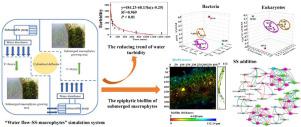Water Research ( IF 12.8 ) Pub Date : 2022-07-26 , DOI: 10.1016/j.watres.2022.118911 Hezhou Chen 1 , Songhe Zhang 1 , Xin Lv 1 , Shaozhuang Guo 1 , Yu Ma 1 , Bing Han 2 , Xiuren Hu 1

|
Suspended sediments (SS) pollution is one of the factors affecting the transfer from turbid water state to clear water state in shallow lakes. However, the interactions between suspended sediments and submerged plants are far from clear. In this study, we investigated the settlement laws of SS in overlying water and its impact on the epiphytic biofilm of Myriophyllum verticillatum and Vallisneria natans under water flow. At least 90% of turbidity can be removed from overlying water, and the decreasing trend of water turbidity fitted the logarithmic decay model in all treatments. The size distribution of SS fit the log-normal distribution model in the first 240 min after SS addition. It should be noted that the main peak particle sizes were lower in treatments with submerged macrophytes (8.71-13.18 μm) than without plants (15.14-19.95 μm). Water flow and SS addition significantly increased the thickness of biofilms attached to M. verticillatum (p < 0.05), but they together significantly reduced the biofilm thickness on V. natans (p < 0.05). SS increased the bacterial α-diversity but decreased eukaryotic one in epiphytic biofilms. However, water flow had a more significant impact on microbial communities (especially eukaryotes) than SS and plant species. The relative abundances of dominant phylum Proteobacteria, class Alphaproteobacteria and Betaproteobacteria, and class Verrucomicrobiae increased in epiphytic biofilms after SS addition. Co-occurrence networks reveal that photosynthetic microbes in epiphytic biofilms played an important role in microbial communities under water flow and SS, and many hub microbes were increased by SS addition but reduced by water flow. These data highlight that SS decline can be predicted by the logarithmic decay model and, SS and water flow can affect the epiphytic-biofilm on submerged macrophytes.
中文翻译:

浅水湖泊水流下悬浮沉积物与沉水植物-附生生物膜的相互作用
悬浮沉积物(SS)污染是影响浅水湖泊由浑水状态向清水状态转变的因素之一。然而,悬浮沉积物与沉水植物之间的相互作用尚不清楚。在这项研究中,我们研究了 SS 在上覆水中的沉降规律及其对万叶菊和苦瓜附生生物膜的影响。在水流下。上覆水体至少可以去除90%以上的浊度,所有处理中水体浊度的下降趋势均符合对数衰减模型。SS 的大小分布在 SS 添加后的前 240 分钟内符合对数正态分布模型。值得注意的是,沉水植物处理的主峰粒径(8.71-13.18 μm)低于无植物处理(15.14-19.95 μm)。水流和 SS 添加显着增加了附着于轮枝藻的生物膜的厚度( p < 0.05),但它们共同显着降低了V. natans的生物膜厚度( p < 0.05)。SS 增加了细菌 α 多样性,但减少了附生生物膜中的真核生物多样性。然而,与 SS 和植物物种相比,水流对微生物群落(尤其是真核生物)的影响更为显着。添加 SS 后附生生物膜中优势门变形菌门、Alphaproteobacteria 和 Betaproteobacteria 类和 Verrucomicrobiae 类的相对丰度增加。共现网络表明附生生物膜中的光合微生物在水流和 SS 下的微生物群落中起重要作用,许多枢纽微生物因 SS 添加而增加,但因水流而减少。这些数据突出表明 SS 下降可以通过对数衰减模型预测,并且 SS 和水流可以影响沉水植物的附生生物膜。


























 京公网安备 11010802027423号
京公网安备 11010802027423号